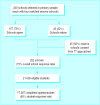Effect of restrictions on smoking at home, at school, and in public places on teenage smoking: cross sectional study
- PMID: 10926588
- PMCID: PMC27448
- DOI: 10.1136/bmj.321.7257.333
Effect of restrictions on smoking at home, at school, and in public places on teenage smoking: cross sectional study
Erratum in
- BMJ 2000 Sep 9;31(7261):623
Abstract
Objective: To determine the relation between extent of restrictions on smoking at home, at school, and in public places and smoking uptake and smoking prevalence among school students.
Design: Cross sectional survey with merged records of extent of restrictions on smoking in public places.
Setting: United States.
Participants: 17 287 high school students.
Main outcome measures: Five point scale of smoking uptake; 30 day smoking prevalence.
Results: More restrictive arrangements on smoking at home were associated with a greater likelihood of being in an earlier stage of smoking uptake (P<0.05) and a lower 30 day prevalence (odds ratio 0.79 (95% confidence interval 0.67 to 0.91), P<0.001). These findings applied even when parents were smokers. More pervasive restrictions on smoking in public places were associated with a higher probability of being in a earlier stage of smoking uptake (P<0.05) and lower 30 day prevalence (0.91 (0.83 to 0.99), P=0.03). School smoking bans were related to a greater likelihood of being in an earlier stage of smoking uptake (0.89 (0.85 to 0.99), P<0.05) and lower prevalence (0. 86 (0.77 to 0.94), P<0.001) only when the ban was strongly enforced, as measured by instances when teenagers perceived that most or all students obeyed the rule.
Conclusions: These findings suggest that restrictions on smoking at home, more extensive bans on smoking in public places, and enforced bans on smoking at school may reduce teenage smoking.
Comment in
-
Protecting children from passive smoking.BMJ. 2000 Aug 5;321(7257):310-1. doi: 10.1136/bmj.321.7257.310. BMJ. 2000. PMID: 10926567 Free PMC article. No abstract available.
References
-
- Gilpin EA, White MM, Farkas AJ, Pierce JP. Home smoking restrictions: which smokers have them and how they are associated with smoking behavior. Nicotine Tobacco Res. 1999;1:153–162. - PubMed
-
- Pierce JP, Gilpin EA, Emery SL, Farkas AJ, Zhu SH, Choi WS, et al. Tobacco control in California: who's winning the war? An evaluation of the tobacco control program, 1989-1996. La Jolla, CA: University of California, San Diego; 1998. http://ssdc.ucsd.edu/tobacco/reports/
Publication types
MeSH terms
Substances
LinkOut - more resources
Full Text Sources
Medical

